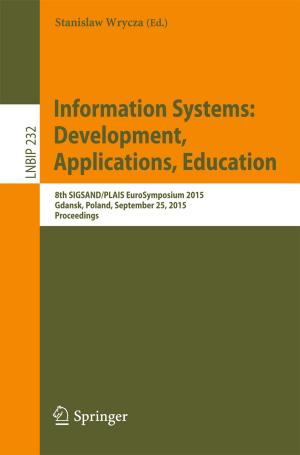Proceedings of ELM 2018
Nonfiction, Computers, Advanced Computing, Artificial Intelligence, General Computing| Author: | ISBN: | 9783030233075 | |
| Publisher: | Springer International Publishing | Publication: | June 29, 2019 |
| Imprint: | Springer | Language: | English |
| Author: | |
| ISBN: | 9783030233075 |
| Publisher: | Springer International Publishing |
| Publication: | June 29, 2019 |
| Imprint: | Springer |
| Language: | English |
This book contains some selected papers from the International Conference on Extreme Learning Machine 2018, which was held in Singapore, November 21–23, 2018. This conference provided a forum for academics, researchers and engineers to share and exchange R&D experience on both theoretical studies and practical applications of the ELM technique and brain learning.
Extreme Learning Machines (ELM) aims to enable pervasive learning and pervasive intelligence. As advocated by ELM theories, it is exciting to see the convergence of machine learning and biological learning from the long-term point of view. ELM may be one of the fundamental “learning particles” filling the gaps between machine learning and biological learning (of which activation functions are even unknown). ELM represents a suite of (machine and biological) learning techniques in which hidden neurons need not be tuned: inherited from their ancestors or randomly generated. ELM learning theories show that effective learning algorithms can be derived based on randomly generated hidden neurons (biological neurons, artificial neurons, wavelets, Fourier series, etc.) as long as they are nonlinear piecewise continuous, independent of training data and application environments. Increasingly, evidence from neuroscience suggests that similar principles apply in biological learning systems. ELM theories and algorithms argue that “random hidden neurons” capture an essential aspect of biological learning mechanisms as well as the intuitive sense that the efficiency of biological learning need not rely on computing power of neurons. ELM theories thus hint at possible reasons why the brain is more intelligent and effective than current computers. The main theme of ELM2018 is Hierarchical ELM, AI for IoT, Synergy of Machine Learning and Biological Learning.
This book covers theories, algorithms and applications of ELM. It gives readers a glance at the most recent advances of ELM.
This book contains some selected papers from the International Conference on Extreme Learning Machine 2018, which was held in Singapore, November 21–23, 2018. This conference provided a forum for academics, researchers and engineers to share and exchange R&D experience on both theoretical studies and practical applications of the ELM technique and brain learning.
Extreme Learning Machines (ELM) aims to enable pervasive learning and pervasive intelligence. As advocated by ELM theories, it is exciting to see the convergence of machine learning and biological learning from the long-term point of view. ELM may be one of the fundamental “learning particles” filling the gaps between machine learning and biological learning (of which activation functions are even unknown). ELM represents a suite of (machine and biological) learning techniques in which hidden neurons need not be tuned: inherited from their ancestors or randomly generated. ELM learning theories show that effective learning algorithms can be derived based on randomly generated hidden neurons (biological neurons, artificial neurons, wavelets, Fourier series, etc.) as long as they are nonlinear piecewise continuous, independent of training data and application environments. Increasingly, evidence from neuroscience suggests that similar principles apply in biological learning systems. ELM theories and algorithms argue that “random hidden neurons” capture an essential aspect of biological learning mechanisms as well as the intuitive sense that the efficiency of biological learning need not rely on computing power of neurons. ELM theories thus hint at possible reasons why the brain is more intelligent and effective than current computers. The main theme of ELM2018 is Hierarchical ELM, AI for IoT, Synergy of Machine Learning and Biological Learning.
This book covers theories, algorithms and applications of ELM. It gives readers a glance at the most recent advances of ELM.















